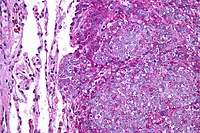
Photo from wikipedia
Ewing sarcoma (ES) is characterized by a reciprocal translocation t(11;22) that results in a fusion of the EWSR1 and FLI1 genes (EWS-FLI). The objective of this study is to identify… Click to show full abstract
Ewing sarcoma (ES) is characterized by a reciprocal translocation t(11;22) that results in a fusion of the EWSR1 and FLI1 genes (EWS-FLI). The objective of this study is to identify protein binding partners of the purportedly undruggable chimeric transcription factor EWS-FLI1 to serve as alternative pharmacological targets for potential ES-selective drug therapies. The literature identifies the orphan nuclear receptor DAX1 (encoded by NR0B1) as a binding partner of EWS-FLI1 the expression of which is restricted outside ES, thereby providing a target for a potential ES selective drug. Yeast two-hybrid (Y2H) screening using EWS-FLI1 as the bait was employed to identify other potential targets. The importance of the binding partners identified by the Y2H screen was initially assessed by a series of proliferation assays involving the ES cell lines EW8, ES7 and ES6 as well as rhabdomyosarcoma cell line Rh30 (Non-Ewing control). Prior to measuring proliferation, cells were transfected a siRNA designed to target the putative binding partner of EWS-FLI1. These cells were then grown alongside cells transfected with a control siRNA over a period of 96 hr. The change in cell confluence in the wells was measured by a live-cell real-time measurement (Incucyte). Gene knockdown was confirmed by RT-PCR and western blot analysis. The proliferation assays showed that the knockdown of DAX1 produces a notable reduction in cell proliferation compared to siRNA control proliferation in all three of the Ewing cell lines (10% to 25%). No significant DAX1 siRNA based inhibition of cell proliferation was detected in the Rh30 non-Ewing control cell line. Three of the proteins identified by the Y2H screen showed significant reductions in ES cell proliferation. Methyl-CpG-Binding Domain Protein 1 (MBD1) knockdown caused the proliferation of the ES cell lines to level off at 60% to 80% within 2 to 4 days. Proliferation of MBD1 siRNA and control siRNA transfected Rh30 cells was similar for the full 4 days of the assay. Mannosidase-α-class 2B-member 2 (MAN2B2) knockdown caused the proliferation of the ES and Rh30 cell lines to level off at 25% to 65% within 1 to 2 days. Mixed-Lineage Leukemia Protein 3 (MLL3) knockdown caused the proliferation of the EW8 and ES7 cell lines to level off at 52% and 70% respectively. MLL3 knockdown did not inhibit the proliferation of Rh30 cells when compared to siRNA control cells. In contrast, ES6 cell proliferation was also not inhibited by MLL3 knockdown when compared to their siRNA control cells. The knockdowns of DAX1, MLL3 and MBD1 suggest that these EWS-FLI1 binding partners would likely provide potential targets for ES drug development. The effect of knocking down Y2H-identified EWS-FLI interactors on colony formation, migration and tumorigenicity is ongoing. Citation Format: Matthew L. Rotondi, Peter J. Houghton. Identification and characterization of EWS-FLI1 binding partners in Ewing sarcoma cell lines [abstract]. In: Proceedings of the American Association for Cancer Research Annual Meeting 2017; 2017 Apr 1-5; Washington, DC. Philadelphia (PA): AACR; Cancer Res 2017;77(13 Suppl):Abstract nr 2560. doi:10.1158/1538-7445.AM2017-2560
Journal Title: Cancer Research
Year Published: 2017
Link to full text (if available)
Share on Social Media: Sign Up to like & get
recommendations!